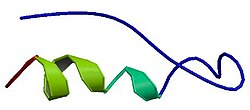Peptid YY
Prijeđi na navigaciju
Prijeđi na pretragu
| edit |
| Peptid YY | |||||||||||
|---|---|---|---|---|---|---|---|---|---|---|---|
 PDB prikaz baziran na 1qbf. | |||||||||||
| Dostupne strukture | |||||||||||
| 1qbf, 1ru5, 1ruu, 2dez, 2df0 | |||||||||||
| Identifikatori | |||||||||||
| Simboli | PYY; PYY1 | ||||||||||
| Vanjski ID | OMIM: 600781 MGI: 99924 HomoloGene: 3066 GeneCards: PYY Gene | ||||||||||
| |||||||||||
| Ortolozi | |||||||||||
| Vrsta | Čovek | Miš | |||||||||
| Entrez | 5697 | 217212 | |||||||||
| Ensembl | ENSG00000131096 | ENSMUSG00000017311 | |||||||||
| UniProt | P10082 | Q3V334 | |||||||||
| RefSeq (mRNA) | NM_004160 | NM_145435 | |||||||||
| RefSeq (protein) | NP_004151 | NP_663410 | |||||||||
| Lokacija (UCSC) | Chr 17: 39.39 - 39.44 Mb | Chr 11: 101.92 - 101.92 Mb | |||||||||
| PubMed pretraga | [1] | [2] | |||||||||
Peptid YY je kratak (36-aminokiselina) protein koga oslobađaju ćelije ileuma i debelo crevo u responsu na unos hrane. Kod ljudi on umanjuje apetit. On je takođe poznat kao PYY, peptid tirozin tirozin, ili pankreasni peptid YY3-36.[1]
Struktura[uredi | uredi kod]
Peptid YY je srodan sa pankreasnom peptidnom familijom, jer je 18 od njegovih 36 aminokiselina locirano u istim pozicijama kao kod pankreasnog peptida.[2] Postoje dve glavne forme peptide YY: PYY1-36 i PYY3-36 koji imaju PP strukturni motiv. Međutim, najčešća forma cirkulišućeg PYY je PYY3-36, koja se vezuje za Y2 receptor (Y2R) Y familije receptora.[3] Peptid YY3-36 (PYY) je linearni polipeptid koji se sastoji od 36 aminokiselina.
Vidi još[uredi | uredi kod]
Reference[uredi | uredi kod]
- ↑ „Entrez Gene: PYY peptide YY”.
- ↑ DeGroot, Leslie Jacob (1989). J. E. McGuigan. ur. Endocrinology. Philadelphia: Saunders. str. 2754. ISBN 0-7216-2888-5.
- ↑ Murphy KG, Bloom SR (December 2006). „Gut hormones and the regulation of energy homeostasis”. Nature 444 (7121): 854-9. DOI:10.1038/nature05484. PMID 17167473.
Literatura[uredi | uredi kod]
- Ekblad E, Sundler F (2002). „Distribution of pancreatic polypeptide and peptide YY.”. Peptides 23 (2): 251-61. DOI:10.1016/S0196-9781(01)00601-5. PMID 11825640.
- Sandström O, El-Salhy M (2002). „Ontogeny and the effect of aging on pancreatic polypeptide and peptide YY.”. Peptides 23 (2): 263-7. DOI:10.1016/S0196-9781(01)00603-9. PMID 11825641.
- Yang H (2002). „Central and peripheral regulation of gastric acid secretion by peptide YY.”. Peptides 23 (2): 349-58. DOI:10.1016/S0196-9781(01)00611-8. PMID 11825649.
- Naruse S, Kitagawa M, Ishiguro H, Hayakawa T (2002). „Feedback regulation of pancreatic secretion by peptide YY.”. Peptides 23 (2): 359-65. DOI:10.1016/S0196-9781(01)00612-X. PMID 11825650.
- Aponte GW (2002). „PYY-mediated fatty acid induced intestinal differentiation.”. Peptides 23 (2): 367-76. DOI:10.1016/S0196-9781(01)00613-1. PMID 11825651.
- Hagan MM (2002). „Peptide YY: a key mediator of orexigenic behavior.”. Peptides 23 (2): 377-82. DOI:10.1016/S0196-9781(01)00614-3. PMID 11825652.
- Mannon PJ (2002). „Peptide YY as a growth factor for intestinal epithelium.”. Peptides 23 (2): 383-8. DOI:10.1016/S0196-9781(01)00615-5. PMID 11825653.
- Tseng WW, Liu CD (2002). „Peptide YY and cancer: current findings and potential clinical applications.”. Peptides 23 (2): 389-95. DOI:10.1016/S0196-9781(01)00616-7. PMID 11825654.
- El-Salhy M, Suhr O, Danielsson A (2002). „Peptide YY in gastrointestinal disorders.”. Peptides 23 (2): 397-402. DOI:10.1016/S0196-9781(01)00617-9. PMID 11825655.
- Imamura M (2002). „Effects of surgical manipulation of the intestine on peptide YY and its physiology.”. Peptides 23 (2): 403-7. DOI:10.1016/S0196-9781(01)00618-0. PMID 11825656.
- Beglinger C, Degen L (2007). „Gastrointestinal satiety signals in humans--physiologic roles for GLP-1 and PYY?”. Physiol. Behav. 89 (4): 460-4. DOI:10.1016/j.physbeh.2006.05.048. PMID 16828127.
- Eberlein GA, Eysselein VE, Schaeffer M, et al. (1989). „A new molecular form of PYY: structural characterization of human PYY(3-36) and PYY(1-36).”. Peptides 10 (4): 797-803. DOI:10.1016/0196-9781(89)90116-2. PMID 2587421.
- Facer P, Bishop AE, Cole GA, et al. (1989). „Developmental profile of chromogranin, hormonal peptides, and 5-hydroxytryptamine in gastrointestinal endocrine cells.”. Gastroenterology 97 (1): 48-57. PMID 2721879.
- Tatemoto K, Nakano I, Makk G, et al. (1989). „Isolation and primary structure of human peptide YY.”. Biochem. Biophys. Res. Commun. 157 (2): 713-7. DOI:10.1016/S0006-291X(88)80308-5. PMID 3202875.
- Lukinius AI, Ericsson JL, Lundqvist MK, Wilander EM (1986). „Ultrastructural localization of serotonin and polypeptide YY (PYY) in endocrine cells of the human rectum.”. J. Histochem. Cytochem. 34 (6): 719-26. PMID 3517149.
- Adrian TE, Ferri GL, Bacarese-Hamilton AJ, et al. (1985). „Human distribution and release of a putative new gut hormone, peptide YY.”. Gastroenterology 89 (5): 1070-7. PMID 3840109.
- Lundell I, Blomqvist AG, Berglund MM, et al. (1996). „Cloning of a human receptor of the NPY receptor family with high affinity for pancreatic polypeptide and peptide YY.”. J. Biol. Chem. 270 (49): 29123-8. DOI:10.1074/jbc.270.49.29123. PMID 7493937.
- Bard JA, Walker MW, Branchek TA, Weinshank RL (1995). „Cloning and functional expression of a human Y4 subtype receptor for pancreatic polypeptide, neuropeptide Y, and peptide YY.”. J. Biol. Chem. 270 (45): 26762-5. DOI:10.1074/jbc.270.45.26762. PMID 7592911.
- Hort Y, Baker E, Sutherland GR, et al. (1995). „Gene duplication of the human peptide YY gene (PYY) generated the pancreatic polypeptide gene (PPY) on chromosome 17q21.1.”. Genomics 26 (1): 77-83. DOI:10.1016/0888-7543(95)80085-Z. PMID 7782089.
- Kohri K, Nata K, Yonekura H, et al. (1993). „Cloning and structural determination of human peptide YY cDNA and gene.”. Biochim. Biophys. Acta 1173 (3): 345-9. PMID 8318545.
- Batterham RL, Heffron H, Kapoor S, Chivers J, Chandarana K, Herzog H, Le Roux CW, Thomas EL, Bell JD, Withers DJ (2006). „Critical role for peptide YY in protein-mediated satiation and body-weight regulation.”. Cell Metabolism 4 (3): 223-233. DOI:10.1016/j.cmet.2006.08.001. PMID 16950139.
- DeGroot, Leslie Jacob (1989). J. E. McGuigan. ur. Endocrinology. Philadelphia: Saunders.